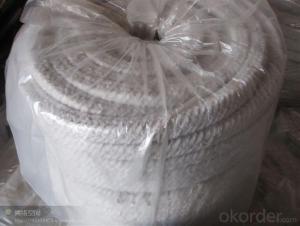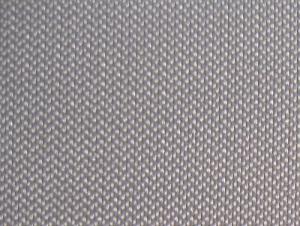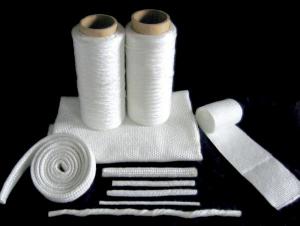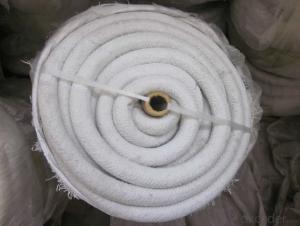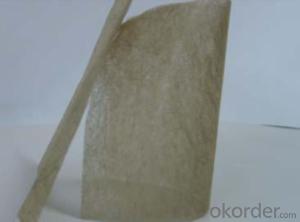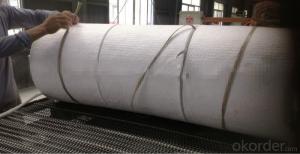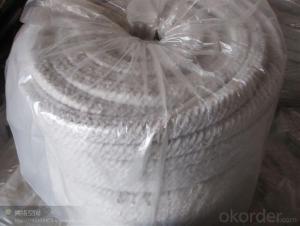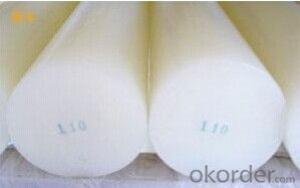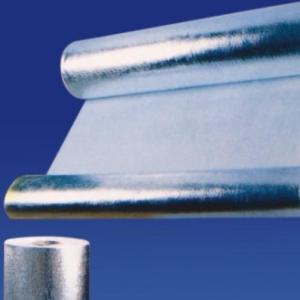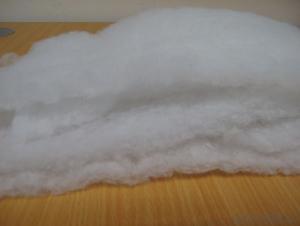ceramic fiber textiles for refractory
- Loading Port:
- Shanghai
- Payment Terms:
- TT OR LC
- Min Order Qty:
- 10 m.t.
- Supply Capability:
- 100 m.t./month
OKorder Service Pledge
OKorder Financial Service
You Might Also Like
Quick Details
| Place of Origin: | (Mainland) | Application: | Refractory | Model Number: | LBR11110904 |
| Brand Name: | Color: | pure white | Working Temperature: | 1100-1350 | |
| Grade: | ST(STANDARD) | Length: | 30000mm | Density: | 500kg/m3 |
| Width: | 10-150mm | Thickness: | 2-10mm | Fiber diameter: | 3um |
Packaging & Delivery
| Packaging Detail: | Wrapped by plastic bag inside,protected by carton box outside. |
| Delivery Detail: | 15 days after deposit |
Specifications
Ceramic Fiber Tape:
1.Glass-fiber reinforced;
2.Environmental-Friendly;
3.Easy to use;
4.Harmless to human.
Characteristics
Good compression strength.
Non-toxicity, environmental protection.
Low thermal conductivity and low thermal capacity.
Good antacid oil resistance and water vapor resistance.
Ceramic Fiber Textile
The Product Description
Ceramic fiber textile includes Ceramic fiber cloth, strap, twisted rope,
round straided rope and square straided rope.All are made from our high quality
ceramic fiber material. They can be used for high temperature applications up to
2300°F. The rope is reinforced with fiberglass filament, and optional Inconel/alloy
steel wire. Ceramic fiber textiles (cloth, tape and rope) contain a certain amount
of binder material which is normally burned at lower temperature and does not affect
the insulation property.
The three different styles are designed to fit different application needs: twisted rope
is a soft rope, while square and round braid are more dense .
Application
Common applications :door seals or caulking for ovens, furnaces and boilers,
expansion joints, cable or pipe wrapping, high temperature seals or gaskets.
widely used in welding, foundry works, aluminum and steel mills, boiler insulation
and seal, exhaust systems, shipyards, refineries, power plants and chemical plants.
We also provide many other refractory and insulation materials, so if you have demands
about them, pls contact us.
Technical data
Item | Cloth | Tape | Round rope | Square rope | Twisted Rope(Yarn) | Twisted rope(wool top) |
Classification Temp °C | 1260 | |||||
Bulk Density kg/m3 | 500±30 | |||||
Organic Content | ≤15 | |||||
Working Temp | 450(Glassfiber Filament) | |||||
1000(Metal Wire ) | ||||||
Loss After Firing(800°C)% | 12±2 | 12±2 | 12±2 | 12±2 | 12±2 | 8-10 |
Size | 30mx1mx2 30mx1mx3 | widen10-120mm length30m | Φ6-50mm
| 20x20 | Φ6-50mm
| Φ6-50mm
|
Any question,pls feel to contact us!
- Q:How do glass fiber textiles compare to carbon fiber textiles?
- Glass fiber textiles and carbon fiber textiles have different properties and uses. Glass fiber textiles are more affordable and widely available, making them suitable for applications where cost is a major factor. They have good strength and flexibility, making them commonly used in industries such as construction and automotive. On the other hand, carbon fiber textiles are extremely lightweight and have exceptional strength-to-weight ratio, making them ideal for high-performance applications. They are commonly used in aerospace, sports equipment, and automotive industries where weight reduction and durability are critical. Overall, glass fiber textiles are more cost-effective and versatile, while carbon fiber textiles offer superior strength and lightweight properties for specialized applications. The choice between the two depends on the specific requirements and budget of the project.
- Q:Can glass fiber textile be used in energy storage?
- Glass fiber textiles, also referred to as fiberglass textiles, possess exceptional thermal and mechanical properties, rendering them suitable for a variety of applications, including energy storage. When it comes to energy storage, glass fiber textiles can be employed as reinforcement materials in the construction of battery electrodes. They offer structural integrity and support to the electrodes, preventing any deformation or damage during the charging and discharging cycles. Another advantage of glass fibers is their chemical inertness, ensuring compatibility with different battery chemistries. In addition, glass fiber textiles can act as separators in energy storage devices like supercapacitors. The porous nature of the textile facilitates easy ion flow and prevents short circuits, thus enhancing the overall performance and safety of the energy storage system. Moreover, glass fiber textiles are lightweight and possess a high surface area, providing ample space for energy storage. This characteristic proves particularly advantageous in applications where weight and volume limitations are crucial, such as portable electronic devices or electric vehicles. To sum up, glass fiber textiles possess the necessary properties to effectively contribute to energy storage systems. Their thermal and mechanical stability, chemical inertness, and lightweight nature make them a viable choice for enhancing the performance and safety of energy storage devices.
- Q:How do glass fiber textiles perform in terms of weight?
- Glass fiber textiles are known for their lightweight nature. They have a very low weight-to-strength ratio, making them highly advantageous in applications where weight reduction is crucial, such as aerospace and automotive industries.
- Q:Can glass fiber textiles be used in automotive applications?
- Yes, glass fiber textiles can be used in automotive applications. They are commonly used in the manufacturing of car parts such as dashboards, seats, door panels, and insulation. Glass fiber textiles provide high strength, durability, and heat resistance, making them suitable for various automotive components.
- Q:Can glass fiber textiles be used in luggage and bags?
- Yes, glass fiber textiles can be used in luggage and bags. Glass fiber textiles are known for their high strength-to-weight ratio, making them an ideal material for durable and lightweight luggage and bags. The glass fibers are woven into a fabric, which can be used to create various types of bags, including suitcases, backpacks, and duffel bags. These textiles offer excellent resistance to abrasion and tearing, ensuring that the bags can withstand the rigors of travel. Additionally, glass fiber textiles provide good protection against moisture and UV radiation, making them suitable for outdoor luggage and bags as well. Overall, glass fiber textiles offer a reliable and long-lasting solution for luggage and bags.
- Q:Can glass fiber textiles be used in upholstery?
- Yes, glass fiber textiles can be used in upholstery.
- Q:Can glass fiber textiles be used in hats or caps?
- Yes, glass fiber textiles can be used in hats or caps. Glass fiber textiles are made from fine strands of glass that are woven into a fabric. This fabric has several desirable properties such as being lightweight, durable, and resistant to heat and fire. These properties make it suitable for use in various applications, including hats or caps. By incorporating glass fiber textiles into hats or caps, it can provide added strength and protection, making them more durable and able to withstand wear and tear. Additionally, glass fiber textiles can also offer insulation properties, keeping the head warm in cold weather conditions. However, it is important to note that glass fiber textiles may not be as soft or flexible as other materials commonly used in hats or caps, so the design and construction of the headwear need to take this into consideration to ensure comfort for the wearer.
- Q:How do glass fiber textiles affect indoor air quality?
- Indoor air quality can be affected by glass fiber textiles in both positive and negative ways. On the positive side, these textiles function as efficient air filters that trap and eliminate airborne particles like dust, pollen, and pet dander. This is especially beneficial for individuals with allergies or respiratory conditions as it reduces the amount of allergens and irritants in the air. However, on the negative side, glass fiber textiles can release small amounts of microscopic glass fibers into the air, particularly if they are old or damaged. Inhaling these fibers can potentially pose a health risk and lead to respiratory issues such as coughing, wheezing, and irritation of the nose, throat, and lungs. Prolonged exposure to high concentrations of glass fibers may even result in more severe conditions like fibrosis. To minimize any potential negative impact on indoor air quality, it is crucial to regularly maintain and clean glass fiber textiles. This involves vacuuming or washing them in accordance with the manufacturer's instructions. Additionally, ensuring proper ventilation in the area can help dilute and remove any fibers that might be released into the air. In conclusion, while glass fiber textiles can contribute to improved indoor air quality by serving as effective air filters, it is important to be aware of the potential health risks associated with the release of glass fibers. Consistent maintenance and cleaning, along with adequate ventilation, can help mitigate any adverse effects and promote a healthier indoor environment.
- Q:Are glass fiber textiles resistant to fading in sunlight?
- Glass fiber textiles are typically resistant to sunlight fading. These textiles have a reputation for being durable and capable of enduring harsh environmental conditions, including long-term exposure to sunlight. Unlike natural fibers like cotton or silk, glass fibers do not easily degrade or fade when exposed to UV radiation from the sun. This quality makes glass fiber textiles highly sought-after for outdoor applications such as awnings, umbrellas, and outdoor furniture, where resistance to fading is desirable. Moreover, glass fibers can be treated with special coatings or additives to enhance their UV resistance, thereby further improving their ability to resist fading in sunlight.
- Q:Can glass fiber textiles be used for reinforcement in concrete pipes?
- Yes, glass fiber textiles can be used for reinforcement in concrete pipes. Glass fiber textiles, also known as fiberglass textiles, are made from fine glass fibers that are woven or knitted together to form a fabric. These textiles have high tensile strength and excellent corrosion resistance, which makes them suitable for reinforcing concrete structures, including pipes. When used in concrete pipes, glass fiber textiles can enhance their structural integrity and durability. The textiles are typically embedded within the concrete matrix, providing reinforcement to resist cracking and improve the overall strength of the pipe. The high tensile strength of the glass fibers helps to distribute the load more evenly and prevent the formation of cracks under load. Furthermore, glass fiber textiles have a high resistance to chemicals and corrosion, which is particularly important in concrete pipes that may come into contact with aggressive substances. This corrosion resistance ensures that the reinforcement remains strong and intact over time, even in harsh environments. Additionally, glass fiber textiles offer advantages over traditional steel reinforcement in concrete pipes. They are lightweight, non-magnetic, and non-conductive, which simplifies installation and reduces the risk of interference with electrical or magnetic systems. Glass fiber textiles also have a lower thermal expansion coefficient than steel, which means they are less likely to cause cracks due to temperature changes. Overall, glass fiber textiles are a viable option for reinforcing concrete pipes. Their high tensile strength, corrosion resistance, and other favorable properties make them suitable for enhancing the performance and longevity of concrete pipe systems.
1. Manufacturer Overview |
|
|---|---|
| Location | |
| Year Established | |
| Annual Output Value | |
| Main Markets | |
| Company Certifications | |
2. Manufacturer Certificates |
|
|---|---|
| a) Certification Name | |
| Range | |
| Reference | |
| Validity Period | |
3. Manufacturer Capability |
|
|---|---|
| a)Trade Capacity | |
| Nearest Port | |
| Export Percentage | |
| No.of Employees in Trade Department | |
| Language Spoken: | |
| b)Factory Information | |
| Factory Size: | |
| No. of Production Lines | |
| Contract Manufacturing | |
| Product Price Range | |
Send your message to us
ceramic fiber textiles for refractory
- Loading Port:
- Shanghai
- Payment Terms:
- TT OR LC
- Min Order Qty:
- 10 m.t.
- Supply Capability:
- 100 m.t./month
OKorder Service Pledge
OKorder Financial Service
Similar products
New products
Hot products
Related keywords
